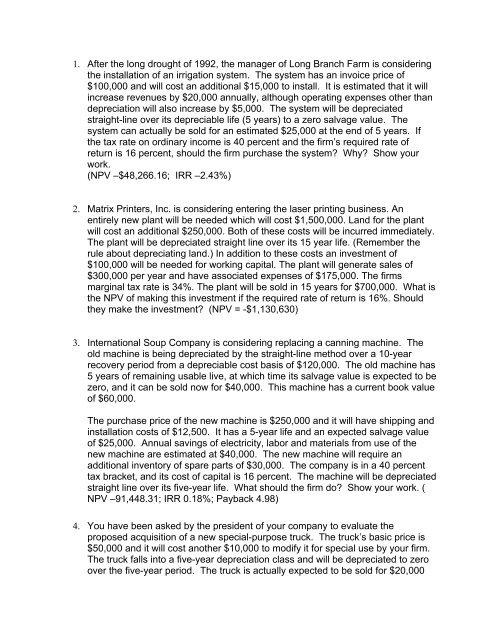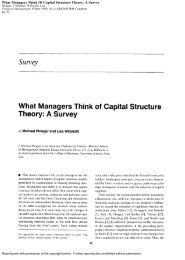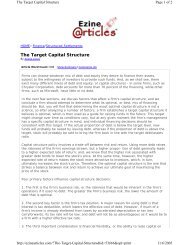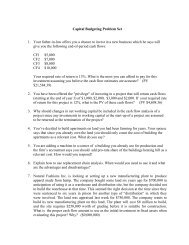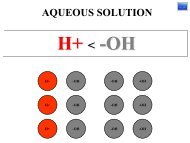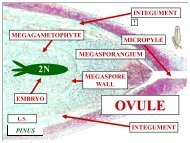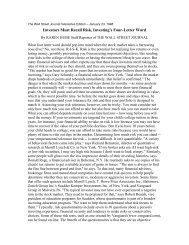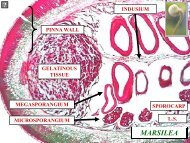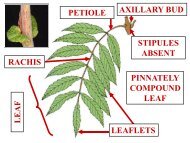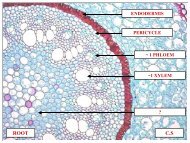Capital Budgeting Practice Problems - Building The Pride
Capital Budgeting Practice Problems - Building The Pride
Capital Budgeting Practice Problems - Building The Pride
Create successful ePaper yourself
Turn your PDF publications into a flip-book with our unique Google optimized e-Paper software.
1. After the long drought of 1992, the manager of Long Branch Farm is considering<br />
the installation of an irrigation system. <strong>The</strong> system has an invoice price of<br />
$100,000 and will cost an additional $15,000 to install. It is estimated that it will<br />
increase revenues by $20,000 annually, although operating expenses other than<br />
depreciation will also increase by $5,000. <strong>The</strong> system will be depreciated<br />
straight-line over its depreciable life (5 years) to a zero salvage value. <strong>The</strong><br />
system can actually be sold for an estimated $25,000 at the end of 5 years. If<br />
the tax rate on ordinary income is 40 percent and the firm’s required rate of<br />
return is 16 percent, should the firm purchase the system? Why? Show your<br />
work.<br />
(NPV –$48,266.16; IRR –2.43%)<br />
2. Matrix Printers, Inc. is considering entering the laser printing business. An<br />
entirely new plant will be needed which will cost $1,500,000. Land for the plant<br />
will cost an additional $250,000. Both of these costs will be incurred immediately.<br />
<strong>The</strong> plant will be depreciated straight line over its 15 year life. (Remember the<br />
rule about depreciating land.) In addition to these costs an investment of<br />
$100,000 will be needed for working capital. <strong>The</strong> plant will generate sales of<br />
$300,000 per year and have associated expenses of $175,000. <strong>The</strong> firms<br />
marginal tax rate is 34%. <strong>The</strong> plant will be sold in 15 years for $700,000. What is<br />
the NPV of making this investment if the required rate of return is 16%. Should<br />
they make the investment? (NPV = -$1,130,630)<br />
3. International Soup Company is considering replacing a canning machine. <strong>The</strong><br />
old machine is being depreciated by the straight-line method over a 10-year<br />
recovery period from a depreciable cost basis of $120,000. <strong>The</strong> old machine has<br />
5 years of remaining usable live, at which time its salvage value is expected to be<br />
zero, and it can be sold now for $40,000. This machine has a current book value<br />
of $60,000.<br />
<strong>The</strong> purchase price of the new machine is $250,000 and it will have shipping and<br />
installation costs of $12,500. It has a 5-year life and an expected salvage value<br />
of $25,000. Annual savings of electricity, labor and materials from use of the<br />
new machine are estimated at $40,000. <strong>The</strong> new machine will require an<br />
additional inventory of spare parts of $30,000. <strong>The</strong> company is in a 40 percent<br />
tax bracket, and its cost of capital is 16 percent. <strong>The</strong> machine will be depreciated<br />
straight line over its five-year life. What should the firm do? Show your work. (<br />
NPV –91,448.31; IRR 0.18%; Payback 4.98)<br />
4. You have been asked by the president of your company to evaluate the<br />
proposed acquisition of a new special-purpose truck. <strong>The</strong> truck’s basic price is<br />
$50,000 and it will cost another $10,000 to modify it for special use by your firm.<br />
<strong>The</strong> truck falls into a five-year depreciation class and will be depreciated to zero<br />
over the five-year period. <strong>The</strong> truck is actually expected to be sold for $20,000
after three years when the project is ended. Use of the truck will require an<br />
increase in net working capital of $2,000 (spare parts). <strong>The</strong> truck will have no<br />
effect on revenue, but it is expected to save the firm $22,000 per year in beforetax<br />
operating costs, mainly labor. <strong>The</strong> firm’s marginal tax rate is 40 percent and<br />
the required rate of return on the project is 13 percent. What should you do?<br />
(NPV -$3143.27; IRR 10.39%)<br />
5. Blue Note Jazz Productions has decided to cash in on the country craze by<br />
starting a subsidiary that will promote concerts by "Country Jazz" artists for the<br />
next three years. <strong>The</strong> country music boom is expected to subside by this time<br />
and the subsidiary will be folded. Blue Note expects that average ticket prices will<br />
be $35 and that ticket sales for the three years will be 300,000 tickets per year.<br />
Fixed cost each year are expected to be $3,000,000 and variable costs are<br />
expected to be 25% of sales. <strong>The</strong> subsidiary will need $4,000,000 in new<br />
equipment to start up and requires a $300,000 investment in working capital. <strong>The</strong><br />
$4,000,000 in equipment will be depreciated straight-line over five years to a zero<br />
salvage value, but will be sold at the end of three years for an estimated<br />
$1,500,000. <strong>The</strong> firm's marginal tax rate is 40%. What is the NPV of this new<br />
investment if the firm's required rate of return is 12%? What is the IRR? Should<br />
the project be accepted?<br />
(IRR 37.20%; NPV $2,276,314.23; MIRR 29.04%)<br />
6. Southwest Airlines is considering the purchase of a new baggage-handling<br />
machine that moves bags quicker and with less damage. <strong>The</strong> cost is $160,000.<br />
<strong>The</strong> machine will be depreciated using the straight line method over its seven<br />
year life. If the machine is purchased, SWA will save $31,000 per year in<br />
damaged bags costs during the first five years. Because of higher maintenance<br />
costs during the last two years the savings will only be $28,000. the firm is in<br />
a34% tax bracket. Given that the firm’s required rate of return is 13%, compute<br />
the NPV and IRR of the investment. Should they make the investment? (NPV –<br />
36,936.03; IRR 5.08%)
7. Ball Corporation is currently evaluating two mutually exclusive projects which<br />
have the following net cash flows:<br />
A<br />
B<br />
0 -$5,000 -$10,000<br />
1 3,000 3,500<br />
2 3,000 3,500<br />
3 3,000 3,500<br />
4 3,500<br />
5 3,500<br />
6 3,500<br />
Both projects have a cost of capital of 10 percent. Totally new equipment must<br />
be procured in 6 years, but Project A would be replicated if it were chosen.<br />
Which project should Ball select, and why?<br />
8. Sony Corporation is considering the purchase of a new phone system for a sales<br />
office in Boise, Idaho. <strong>The</strong> Lucent Technologies system costs $54,000, has<br />
annual operating expenses of $4,000 and an expected life of 9 years. <strong>The</strong><br />
Toshiba system has a cost of $48,000, annual operating expenses of $4,000 and<br />
an expected life of 7 years. Ignoring depreciation and taxes and assuming a cost<br />
of capital of 9 percent for such an investment, which system should Sony<br />
purchase? You are free to use either replacement chain or EAA/EAC analysis.<br />
( Lucent EAA -13,007.14, NPV-77,980.99; Toshiba EAA -13,537.14, NPV -<br />
68,131.81)<br />
9. A small real estate office needs a new copier. <strong>The</strong>y have their choice between<br />
leasing a new copier for $2,000 per year with all maintenance included or they<br />
can purchase their own copier for $4,200 and would incur $1,200 per year in<br />
operating costs. Paper and cartridge costs for the copier would be identical in<br />
either case. <strong>The</strong> lease would be for a total of 6 years and the copier, if bought,<br />
would have a useful life of 6 years and no expected salvage value at the end of<br />
that time. Determine if owning the machine would be cheaper on a per-year basis<br />
than leasing the machine. <strong>The</strong>n firm’s tax rate is 34% and the proper required<br />
rate of return for the project would be 7%. (Annual after-tax cost of lease is<br />
$1,320 per year. NPV for purchase of copier is -$6840.66 giving an EAC of<br />
$1,435.14 per year. Take the one with the lowest annual cost – the lease.)<br />
10. You have become very successful and are considering the purchase of a plane<br />
for your firm. <strong>The</strong> Piper model has an initial cost of $375,000, annual operating<br />
costs of $24,000 and a salvage value of $150,000. Its estimated holding period<br />
is 7 years. <strong>The</strong> Cessna model has an initial cost of $325,000, but annual<br />
operating costs of $29,500 and an estimated salvage value of $100,000. Its<br />
estimated holding period is 8 years. Your cost of capital is fifteen percent.<br />
Ignoring depreciation and taxes, which model would be the best choice assuming<br />
they both would perform the required tasks?


